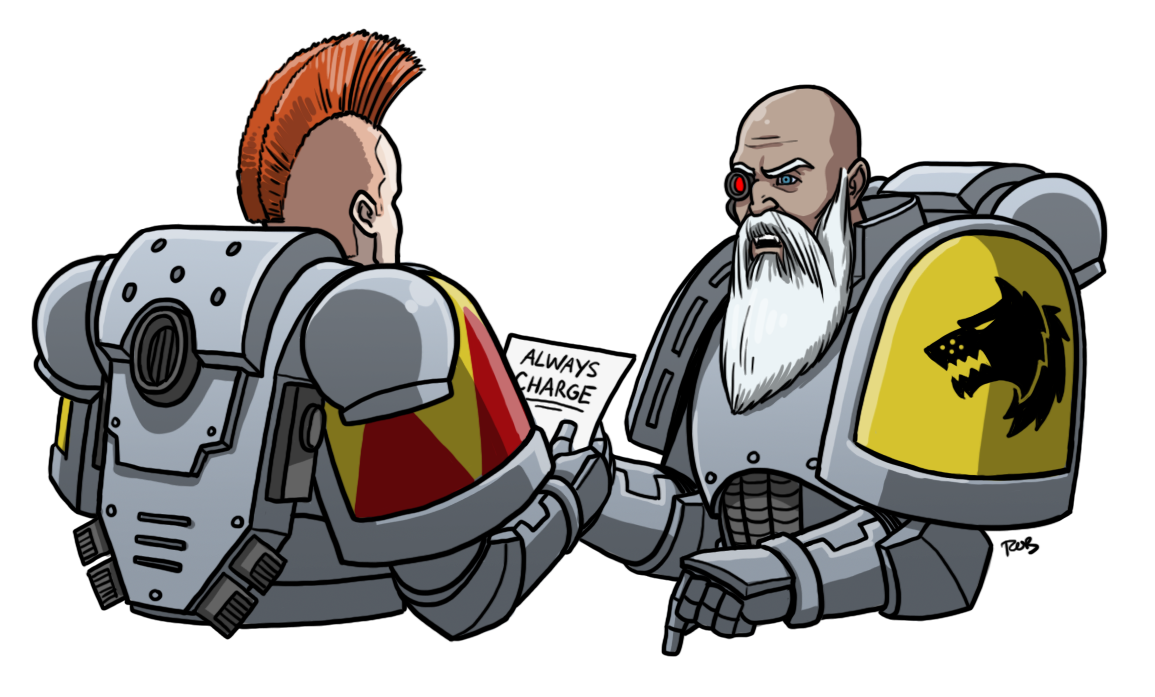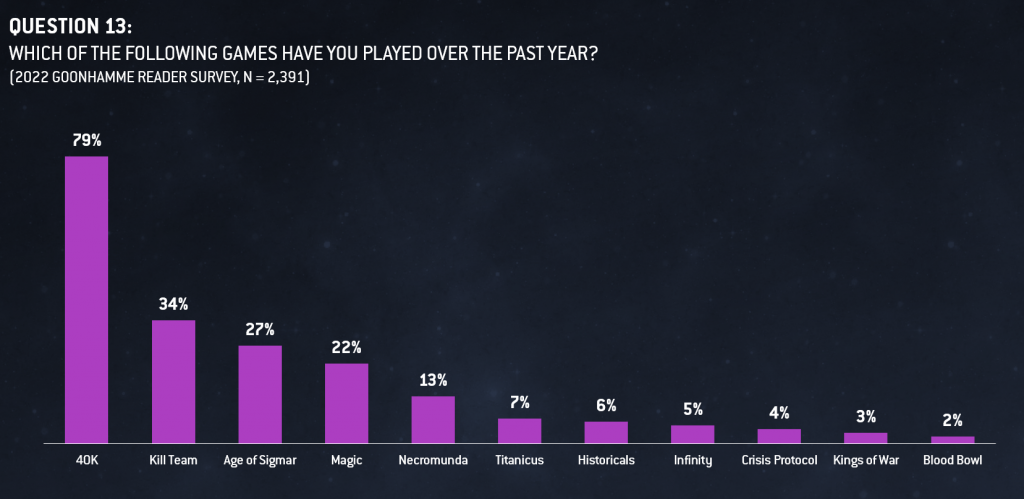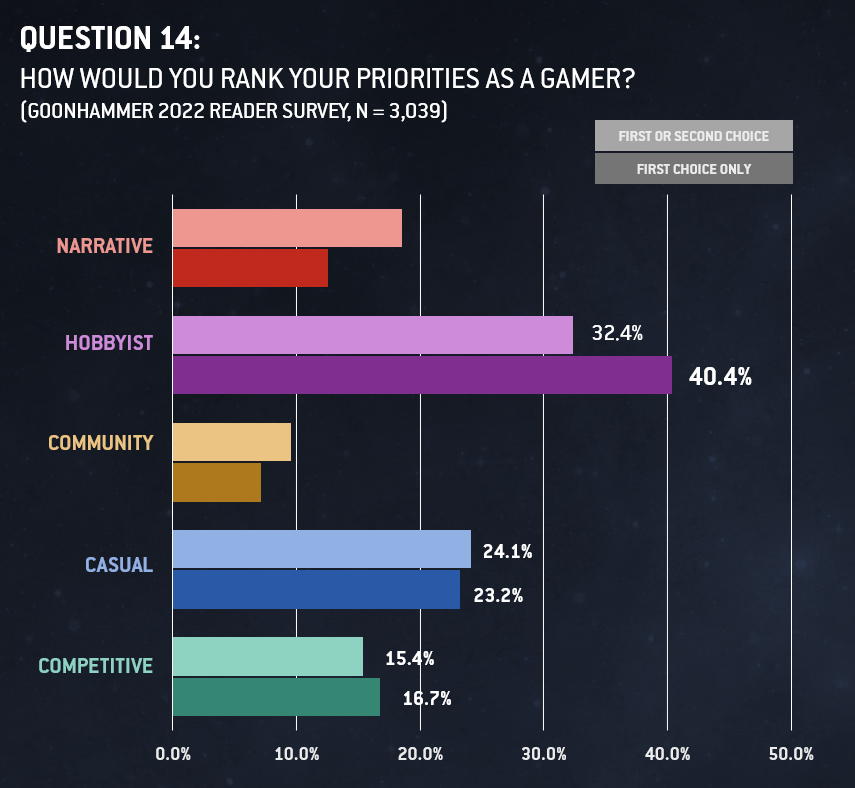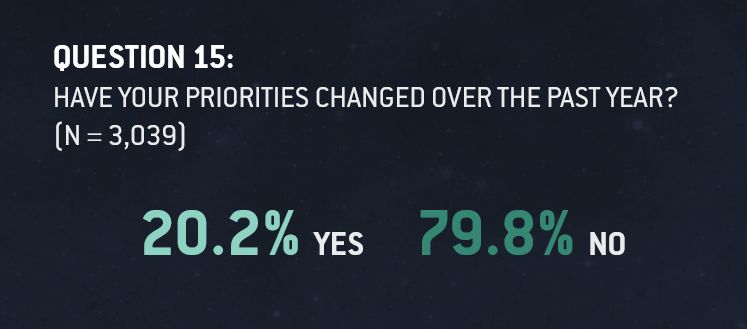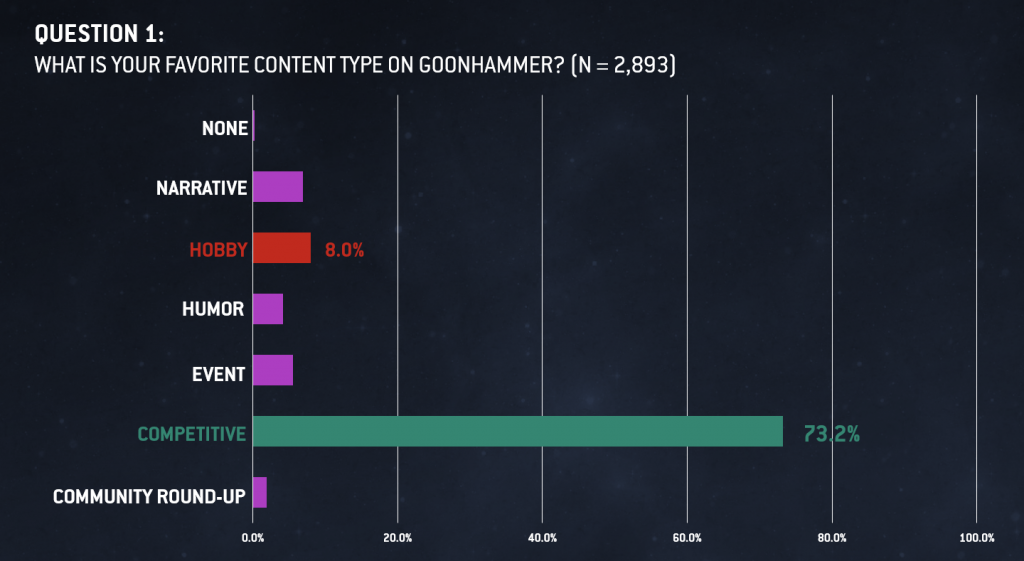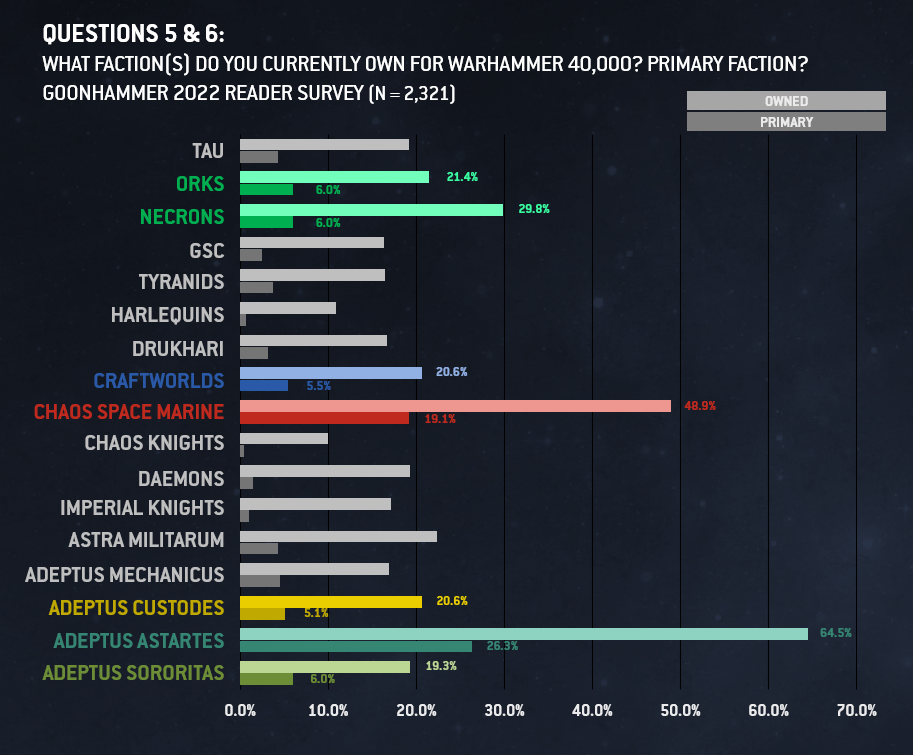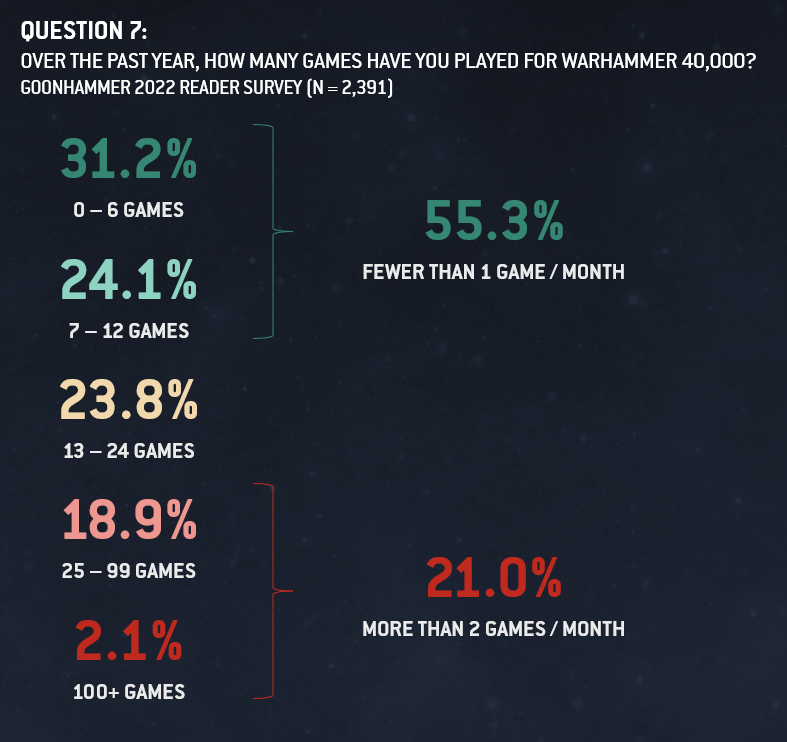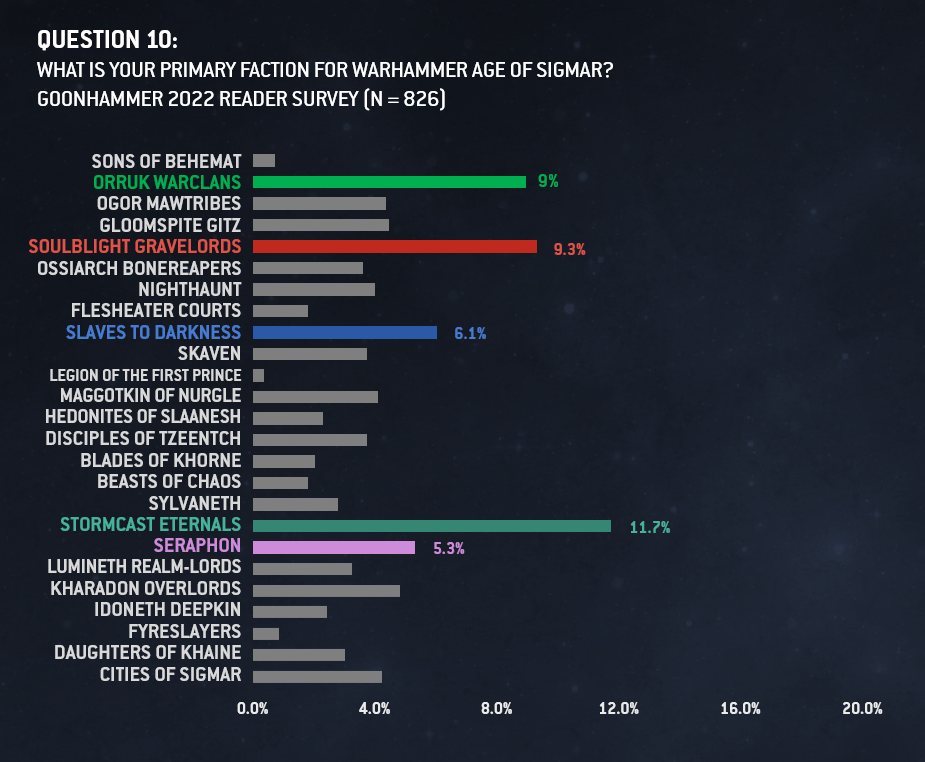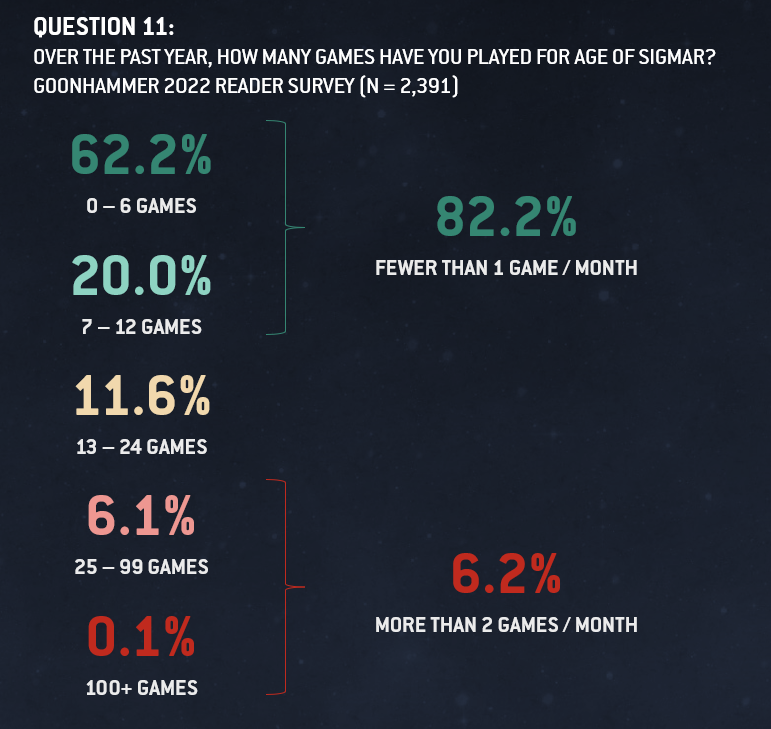We recently took pause to reach out to you, our readers, to learn more about you and ask you how we’re doing. You responded with gusto! In total we received over 3,000 responses and over 4,500 comments to our reader survey in just five days. In total we recorded a 67% response rate, which is frankly fantastic. We’re confident that this is one of the largest independent surveys of hobbyists ever and we’re more than buoyed by your enthusiasm for the hobby and our work. Thank you!
As promised, we want to share some of what we learned, respond to some representative comments, and look forward on the upcoming year for Goonhammer. And because we’re huge data nerds, we’ll also take an opportunity to analyze some of the data and what it means for the games we love.
Understanding the Warhammer Player Universe
This is something that we discuss a lot internally, because it’s something we’re constantly trying to do. We also occasionally see discussion about the player set, with a sort of cultural divide between competitive and casual players (more on that in a bit). At the core of the issue I’d suggest that it’s really, really difficult to understand what the Warhammer player base looks like; players run the gamut from top players in the ITC to kids playing on their floor. If you step back for a minute and look at Warhammer 40k – GW’s most popular game – then you can do some back-of-the-napkin math using different communities to get at game sizes:
- Tournament players. The 2021 ITC standings recorded just over 13,300 players in what was the biggest year yet for competitive events. Of these, the majority recorded only 1 event score.
- Competitive Discussion. The Competitive Warhammer subreddit, which is primarily 40k, has about 76,000 members. So at most around 1 in 6 of those members have likely played in an ITC-recorded competitive event in the past year.
- Online Engagement. The Warhammer 40k subreddit, which is primarily casual and hobby content, has 462,000 members, so we can estimate that around 1/6 of the engaged online audience for 40k is into competitive discussion and content online.
- Warhammer Community. Based on site traffic stats we can access, we’d estimate that the mothership site sees around 2.8 million monthly visitors. Of those, we need to weed out the players who are *only* Age of Sigmar, but we’ll use our survey data for that – about 15% of our AoS players only play AoS, and so we’d estimate that about 2.4 million of the people heading to Warhammer-Community each month are 40k players.
OK, so where are we so far? We’ve estimated a a player/hobby/customer base of about 2.4 million people for 40k, of whom competitive players represent about 0.6%. And that’s only the English-speaking universe for Warhammer 40k. We know there are players around the globe, like Spain’s dedicated Kill Team community or the burgeoning competitive community in Japan. Goonhammer, the ITC, the subreddits, and Warhammer-Community cater to a primarily English-speaking audience. And that’s not to mention the players and hobbyists who never visit the Warhammer-Community site. If we go by Games Workshop’s revenue numbers, the non-English speaking parts of the world make up about 25% of the company’s revenue, so we can probably put the upper bound on worldwide 40k players at something like 3.5 to 5 million, and the overwhelming majority of them are casual players and hobbyists.
So why do we talk so much about competitive play and tactics? Why does it matter? Why should Games Workshop listen to competitive players and issue balance updates if the vast majority of players don’t play in events? Well, it turns out there are some compelling reasons, and we’re going to tackle those through this article. Strap in.
The Game Splits
One of the first questions we asked about is what games you’re playing. And it should be no surprise that most of you play 40k – it’s certainly the game we focus on most prominently, though we’re working to expand.
After that our second most popular game among readers is Kill Team (34%), followed by Age of Sigmar (27%). I suspect that while 22% of you play Magic, that has more to do with Magic being the most popular game on the list rather than a strong interest in our Commander articles, but if you’re in to Magic and haven’t read our coverage, we publish new Magic articles every Thursday.
Of these, we’re working to ensure reliable weekly Kill Team coverage, but Age of Sigmar is the area we’ve really been working to grow things out – we added several AoS writers over the last year, including Bair, Magos Sockbert, and JoeK, and we’ve gotten great content from Liam Jordan and PlasticCraic at times as well. Our goal is to get up to something more like 2-3 AoS articles per week, but we’re still looking for talented players to help us write about the game and cover gaps, and also there just isn’t quite the same fire hose of content for AoS as there is for 40k (though the next few months certainly figure to be more hectic).
It’s also great to see as many of you playing Historicals, Infinity, Crisis Protocol, and Kings of War! Malifaux (1%) didn’t make the chart, but is also an up-and-comer for us, and these are all games we’re looking to expand on in the future so if you’re a player on these and there’s content you want to see, let us know.
Most of You are Hobbyists and Casual players
Everyone knows Goonhammer is a hardcore site for competitive players, right? That’s what you’re here for, right? Well, turns out most of you are hobbyists and (filthy) casuals.
We asked our readers how they rank their priorities as a gamer – though not specifically for any one game, mind – amongst the categories of Narrative, Hobbyist, Community, Casual, or Competitive (n=3,039). And it turns out that more than 40% of you think of yourselves as Hobbyists first, with Casual being both the next most likely pick and the most likely second pick.
And regardless of where you start – hobby or casual – 38% of you pick the other as your second choice, which means that 24% of you are hobby + casual.
What about the rest? Well 17% of you were competitive first, and for competitive players the most common second priority (38%) was hobby, followed by community (27%). And this is one of the most interesting parts of the whole survey to me:
- 27% of Competitive-first players list community as their second priority (rank: 2nd)
- 11% of Casual-first players list community as their second priority (rank: 4th)
There’s an entire book’s worth of things to write about this and what it suggests. Casual-first players were less likely than hobby-first players to prioritize community, and only Narrative-first players were less likely (6%). But why is that the case? I have two theories on this, which are not exclusive and likely both contribute:
- Casual and Narrative players are more likely to retreat to small “in-groups” of friends to play with, favoring games at home over building communities in public spaces
- Competitive play stands up much better to the rigor and stresses of playing against strangers with little pre-game communication
The net result here is that when local communities are built around a store, it may be more likely that they’ll be built around competitive play or semi-competitive play, such as a league. That’s pretty interesting – and something we’ll come back to later.
Approximately 20% of you indicated that your priorities had changed over the past year, but there were no strong trends toward or away from any one priority area. Personal, financial, or COVID-related reasons for priority changes were common.
But Most of You Are Here for That Sweet, Sweet Competitive Content
We were surprised to find that such a large percentage of you are hobbyists and casual players. But we also have about half a million readers come through each month, so even if we captured all of the ITC and competitive Reddit, that only makes up about 1/6 of our readers, and that means the rest of you must be here for something.
So we asked what type of content our readers preferred and the overwhelming response favored our competitive-focused content at 73.2%.
Only one third of our readers say that competitive play is either their first or second priority, but nearly three fourths of you like our competitive content best of all. First off, thanks – we work very hard on that content – and second, this speaks to what I believe is another core issue. Specifically that good tactical content is useful for everyone, and that wanting to win games, wanting to know how to build an army, and understanding the game are things that appeal to casual and narrative players as well.
That’s pretty cool and makes a lot of sense – it’s one of the reasons we try to avoid glib “analysis” and takes like “don’t play this, it’s bad” when we write our articles (especially those focused around getting started) and instead focus on making the best plays with what you have – for most players the way armies are built is not “let me plan an army, test it with proxies, then build it to compete,” but rather “how do I make the best thing I can from this pile of minis I’ve painted?” And the reality is that a lot of suboptimal lists can go 3-0 at an RTT with a little luck.
The rest of you are here for Hobby content (8%), Narrative content (Beanith will be glad to hear it), and Humor, which I’m gonna guess is split something like 80/20 Meatwatch fans and people who really liked Your Dice/Legion suck and wish we’d do more of that kind of stuff. You are among my favorites, and the short answer is: We’ll try.
How Do You Take Your Content?
We also asked you how you consume your content, format-wise. If I’m honest, this one’s a bit of a “blah” question, in part because we’re pretty sure we’ve managed to attract all the sickos out there who prefer long-ass written articles. The people who want podcasts can go listen to podcasts. But it’s still cool to see.
We also asked you whether you preferred each format as well. When asked for preferred format on tabletop gaming content, readers indicated a strong preference for written content at 76.6%. But a lot of you also said you watch video content (60%). Though it’s worth noting that while most of our readers watch videos, few of you seem to actually prefer that format. Which, extremely same, people. Extremely same.
Brainwashing the Masses
We want to highlight that a whopping 93.9% of you readers say that Goonhammer has influenced how you play or think about your chosen faction. That is a staggering number, but even moreso, 72.2% of you said that Goonhammer has influenced your purchase decisions. On the one hand, we’re thrilled that you trust us to this extent, and that we’re able to hold this level of influence. On the other it’s frankly, irresponsible to let us have it, given that now we’re liable to do things like kick-off a run on the worst units in the game with our upcoming, secret Blunderdome 2 article series. I blame all of you for putting us in this situation. This is your fault.
Alright, let’s talk about some of the individual games we cover, and then we’ll come back to the bigger question about understanding the Warhammer player base. I haven’t forgotten that’s what we were talking about.
Warhammer 40,000
One of our interests this year was how our readers engage in the game of Warhammer 40,000 – we wanted to know how many of you played in this pandemic year (78.8%, n=3,039), how often, and which factions you own and play.
Unsurprisingly, we learned that the only majority-owned faction in the game are the armored angel protectors of the Adeptus Astartes, of which nearly 65% of 40k players own. After marines the next most popular faction is Chaos Space Marines (of all flavors), at about 49%, and in the distance, Necrons, Orks, Craftworlds, Custodes. No other factions were owned by at least 20% of our readership (n=2,321). 95% of players own 2+ factions, regardless of whether their priorities are casual, competitive, hobby, or narrative-focused.
This is about in-line with what we’ve seen on other similar surveys and isn’t terribly surprising: GW releases more models and support for Space Marines than any other faction. But that always begs the question: Does the tail wag the dog when it comes to Space Marines? By that I mean, does GW release more models and rules for Space Marines because more people play them, or do more people play them because of the greater support?
Well, I think it’s more the latter, and the reason for that is that while 65% of players own Marines, only 26% identify them as their main faction. That’s a drop of more than 50%. It’s almost impossible to buy 40k products for any length of time and not end up with some Marines – they’re in every starter kit! At the same time you can see this reflected well in Necrons, the third most-owned faction despite only having a 6% primary play rate. Necrons were the non-Marine faction in the 9th edition starter boxes and Indomitus boxed set. And Chaos Space Marines, besides being the raddest faction in the game, were the antagonists of Dark Vengeance, the starter box for 6th and 7th edition, and Death Guard (rolled up here into CSM) were the antagonists of Dark Imperium, the 8th edition boxed set.
Which isn’t to say that Marines aren’t popular – they’re certainly rad and it’d be a mistake to say that people don’t like them. But you can’t look at that “Necrons” bar being the third highest and not immediately think “what’s going on there?” This is also something borne out in our ITC Battles App data as well – Necrons and Death Guard frequently “punch above their weight” with regard to the volume of games played.
The moral of the story is: If you want players to own a faction, put it in the starter set. This data also shows that most players have multiple armies, because there’s a dropoff of 50%+ for every faction.
Boon: I’m also in agreement that the support has gone a long way to establishing the primacy of Space Marines in 40k. Slightly at odds with Rob here, but I think the factor in which they drop off from owned vs primary actually buoys that idea. It isn’t as great of a drop as other factions at a ~2.5:1 ratio with every other faction (except Sisters 3) seeing a ratio of 3.2:1 up to as high as 17:1 and an average of over 5:1 . That ratio would indicate that Space Marines are ‘stickier’ which certainly supports the idea that a lot of love raises both their ownership but also their primacy of factions played.
Chaos Space Marines see about the same ratio and has also been a heavily supported faction in terms of range of releases, sub-faction rules, and multiple edition starter set releases, especially in recent times. The Necrons by comparison look baffling at the third-most-owned faction but with the most recent Indomitus release as well as their rather limited support over the years, the ratio at 6:1 might support the idea that they’re more likely to be owned as a result of starter set inclusion, but as a primary faction they require consistent support. Outside of SM, CSM and Necrons, the average faction is played by 3.6% of players as primary and owned by 16.2%. Necrons are the only non-SM or non-CSM faction to have seen an edition starter release in at least 14 years which might explain their outlier status.
The last non-SM/CSM release being Orks (5th Edition – Assault on Black Reach). Prior to them, Tyranids (4th Edition – Assault on Macragge), Drukhari (3rd Edition – Untitled), and Orks again (2nd Edition – Untitled). I’d hypothesize that ownership of non-Necron factions is buoyed by how well they can soup into their counterpart factions (Aeldari, Imperial, Chaos, Hive Mind, etc)
We also asked our 40k players how many games you’ve played. And it turns out that a little more than half of you (55%) played fewer than one game per month over the last year, while 21% of you played more than two games per month, including the 2% of you who got in more than 100 games. That’s a pretty big spread!
As you might expect, the number of games people play vary by how they approach the game. We asked players if they’ve played either Crusade or at a competitive event in the past year and 42% of you have played Crusade over the past year or made a Crusade roster, while about one third (34%) say you’ve played in at least one competitive event.
As it turns out, these are both powerful motivators to play:
- 82% of players who played in a competitive event – and 84% of players who say competitive play is their first priority – played more than 12 games (more than one game per month) in 2021. Only 7% played 6 or fewer games.
- Narrative and Casual players were more similar, but Crusade was a big factor – more than half (52%) of players who played Crusade in 2021 got in 13+ games. While more than half (52%) of players who did neither Crusade nor a competitive event played 6 or fewer games.
There are some interesting dynamics here. The first is that, if you’re a player who considers casual play to be a priority, then chances were you played 12 or fewer games last year, and one third of you played 6 or fewer. It’s entirely likely that you went an entire year without ever actually having to worry about or experience the unbalanced play from the Codexes for Drukhari, Adeptus Mechanicus, or Orks before they received balance adjustments. An entire year could have passed and you could be wondering what all the fuss was about. Or maybe you could have played one of those armies and you had 1-2 games with the new rules and thought they were just fine. For armies that make up around 4-6% each of players’ primary armies, there’s a good chance you never saw them.
The flip side to this however is the outsized impact: If you did happen to come across these armies, there was a good chance you had a bad time in what was an outsized percentage of your play time in 2021. It was difficult to build an actual bad list with Drukhari, and if your local group had a Drukhari player eager to take their new army out for a spin there’s a solid chance that you spent anywhere from 17-51% of your play time in 2021 getting dumpstered. It’s an odd situation where your chances of not interacting with broken stuff was pretty low, but if you did, it probably ruined a greater proportion of your play time.
If you were surprised by that Crusade number, well we kind of were too. But we also knew that Crusade rules, which is why we’ve been working hard on Administratum.
Warhammer: Age of Sigmar
Similarly, we asked you about Age of Sigmar. Just over one fourth of our readers – 27.4% – said you’d played at least one game over the past year, and of those, 18% of you have played in a competitive AoS event while 24% of you have tried Path to Glory. When it comes to factions, Stormcast Eternals are far from being the “Space Marines” of Age of Sigmar, with only 12% of players considering them to be their primary faction. The second highest picks? Soulblight Gravelords (9.3%) and Orruks (9%), who also featured in the Dominion boxed set.
Age of Sigmar has a more casual scene than 40k, and that translates both to player priorities and volume of games played. 82.2% of our AoS players say they played fewer than 1 game per month last year and just 6.2% said they got in more than 2 games per month. Just 0.1% of respondents played more than 100 games of Age of Sigmar on the year.
However, we note that one hero reportedly played both 100+ games of Age of Sigmar and 100+ games of Warhammer 40,000 in 2022.
Other Games
Before we come back to the competitive play question, let’s talk about the other games – we do cover more than just warhammer here, after all. This is mostly going to be bullet point trivia.
- Kill Team is our second most popular game among readers, and 10% of our Kill Team players have played in a Kill Team competitive event.
- Necromunday is one of our oldest series, and 13% of our readers said they played in the last year. What’s more impressive is that more than half of those – 55% – said they played in a Necromunda campaign last year. That rules!
- 22% of our readers played Magic: the Gathering last year. Just under a third of those readers (30%) played in a competitive event for Magic last year, though I suspect these were primarily online.
- 5% of our readers play Infinity, and of those 29% played Infinity competitively last year.
- 4% of our readers play Marvel Crisis Protocol, and of those 24% played in a competitive MCP event last year.
The numbers here are interesting in that they kind of hammer home just how different the Age of Sigmar community is when it comes to competitive play, but hopefully that’s something that will continue to change as the game grows and the competitive community around the game improves.
So Why Does Competitive Play Matter?
Alright, so if competitive players represent such a tiny fraction of the player base, why do they matter? Why should Games Workshop spend time on competitive play, and work toward competitive balance in its games, even for players who ostensibly won’t play in events and may never see the benefits of those efforts, or feel the downsides of bad decisions?
We’ve already touched on a few of these but it’s worth revisiting them here:
- Casual players still value competitive content and balance. While casual players may play fewer games and they may not participate in events, they still engage with content about tactics, lists, and game balance. Only one third of our 40k readers played in competitive events last year, but 70% of you come here for competitive content. Even casual and narrative players still enjoy the challenge of tactical play and attempting to outsmart an opponent, and having a balanced game makes that more likely.
- Individual games matter more to casual players. On that same note, casual players play significantly fewer games, and while that means they may be more likely to dodge the effects of bad balance – especially if it’s corrected later – it also means that if they do have a bad game because of a perceived mismatch of skill or army quality, it’s going to paint a much larger proportion of their experience in a negative light.
- Competitive players are, on the whole, more concerned with building and expanding the community. This was a bit surprising to me but it makes sense when you consider how common it is for competitive players to start organizing events in their area. Competitive play tends to be a bit more resilient to the challenges of playing against strangers, in part because it settles (to some extent) the issues of mismatched expectations with regard to intent – if both players arrive at the table expecting the opponent to be trying their best to win, then they’ve removed at least one of the major areas of conflict in expectations from the game. Competitive players are good for expanding the game, creating events and communities that bring new players in and encourage existing players to play more games.
- Most casual players don’t engage at all. In a real sense we have to worry a bit about the sample bias in our survey: Our readers are a self-selected bunch of gamers who are likely to be more dedicated than the average player for any of these games. There’s a massive group of players out there who didn’t take our survey and who just don’t read or engage with Warhammer content on a regular basis. And that’s also the rub: The players who care the most about the game are naturally the ones playing it the most, and as a result, the most vocal about its state. This is a fine line to walk because you need a game that works for competitive players without alienating casuals – and that’s typically a matter more of complexity and fun factor. But if you’re looking for ways to convince the average casual player to start getting more than 0-6 games in per year, getting them into competitive play or Crusade are the two best avenues available.
- Competitive Play is the most visible aspect of the hobby. Because Competitive players focus on building competitive communities, because competitive play happens in public, and because casual play is more likely to happen in private at homes, competitive play ends up being the most readily visible aspect of the game. Which means it’s also the most likely aspect of the game to draw in new players. A strong competitive game that looks fun will naturally attract more players, and as a result, attract more casual, narrative, and hobby-focused players to the game as well. If you want to promote the game, you have to promote it where people can see it and as much as I love beerhammer at home, nobody sees those games.
So there you have it. Competitive players are simultaneously so small a portion of the GW audience that they don’t really matter, but at the same time, it’s still important that Games Workshop think about competitive play and build a game that works for competitive players and casual players alike. Ultimately, a game that’s competitively balanced will benefit players at all levels.
And one final note on this: Competitive and Casual aren’t opposite ends of a spectrum. Yeah, players who prioritize one over the other are different in some interesting ways, but lots of casual players come to Goonhammer for competitive content. And likewise lots of Competitive players in our survey say they just like to throw dice, paint minis, or run Crusade games. At the end of the day both want to play fun, challenging games against good people.
Goonhammer Redesign and Advertising
As a last bit, we sought some feedback from you on your experience to date with the new site redesign as well as the recent decision to bring in advertising to help with costs and drive future growth. We asked readers to rate their experience on both the mobile and desktop versions of the site. Overall, you gave us above average marks for both, and very few of you had strong negative feelings about the advertising. That’s good – we don’t like having advertising here either, but at this point we think it’s a better option than making the content subscription-only. Overall, we feel confident that we’re doing a pretty good job on the redesign and advertising decisions, and the feedback we got about improving usability is already being taken into consideration.
Reader Comments
Boon: I spent a lot of time going through each comment, reading it, re-reading it, probably re-reading it a third time if it was late enough. There were a lot of them, and many more than last year. It was both humbling and exciting in how appreciative everyone was of the work that goes into Goonhammer and there was certainly something for every one of our contributors in the ~4,500 comments left by you. It’s clear you are all as passionate as we are.
That said, it’s clear that there are areas where we can seek to improve over the year and in the future. These comments were noted, categorized, assessed, and we’d like to take the opportunity to acknowledge certain representative feedback and discuss how we might address them.
Generally speaking, constructive feedback came in a few areas, many of them tied to the website design and advertising schemes – this is likely because the open question field immediately followed that section and anchor biased the responses. These have been categorized as follows:
- Indexing & Search – 37.8%
- Site Layout & Features – 20.9%
- Banner Links – 14.8%
Indexing & Search
The most common constructive feedback had to due with capability to search and find various landing pages, particularly as it relates to the mobile platform as illustrated by a couple of comments here
“The search function on goonhammer mobile is broken I have to make a new tab and google goonhammer then whatever I want to find instead of using the search function on the site”
“… on mobile, it is very hard to find the hub pages for columns such as ‘getting started’ or ‘start competing’. The link in the dropdown just gives you every article with that tag, which includes all games and even articles about running tournaments and the like…”
In general, archiving, tagging, and categorization were pain points for our users with many individuals citing simply leaving Goonhammer, googling for their desired article, and then reentering Goonhammer that way. This is a real concern for us as we seek to provide you with all the resources you need, past and present, and realize that many articles are references weeks, months, even years later.
Site Layout & Features
The second most common type of feedback we received was based around site feature requests, particularly as it relates to mobile. Feedback ranged from inclusion of a dark mode option to support tools like a “back to the top” button. Some commenters spoke to the ordering or listing of items in our carousel and columns as noted here:
“The new format sometimes makes it difficult to read and discover the newest articles because of the way new content is placed in the top banner/row rather than among the other similar content. It’s not a big deal, but I’ve for sure come to the site looking for a particular review of a new release and struggled to find it once or twice with the new site format.”
“…I do wish I could scroll through longer lists of articles when looking back, though (I think I can only see 6 or 8 at a time now between button clicks, which sucks). “
Again, ensuring you are able to access the content, and importantly, not miss on content you’d have liked to access is important to us, and we’ll seek to examine what changes we can make this year to better support you.
Banner Links
This one is straightforward – the banner images and overlaid text don’t serve as a unified link. Also the Goonhammer logo at times doesn’t act as a button back to the home page.
“Making the whole image of the article clickable instead of just it’s title when its on the main “billboard” section would be a lot better.”
“Can you make clicking on the Goonhammer logo take me to home on mobile”
I, am not a web or app developer, and as a marketer will confidently tell you that this is an easy fix no problem. The reality is that I have no idea and I’m sure it’s way more complicated than I imagine but it’s been noted by enough of you to bear further examination. I also personally support this since I’ve also had this issue on mobile, in particular.
Battlefleet Gothic
Finally, something near and dear to my heart:
“What happened to the combined BFG/40k campaign?”
Sigh. I know. I really want to kick this back up, but COVID and time commitments for campaign players made this challenging for something as complex as the integrated campaign. I am looking to kick this back up in the future and probably just restrict it to the BFG portion – stay tuned as there is more to discuss in terms of painting fleets and terrain as well as the campaign itself.
Final Thoughts
That’s it for this year’s survey. Your feedback has been extraordinarily helpful to us and both our members and contributors will have the opportunity to review your content suggestions to help spark their own ideas and passions. We again thank you all for your insight and we look forward to an exciting 2022 together!
Have any questions or feedback? Drop us a note in the comments below or email us at contact@goonhammer.com.
